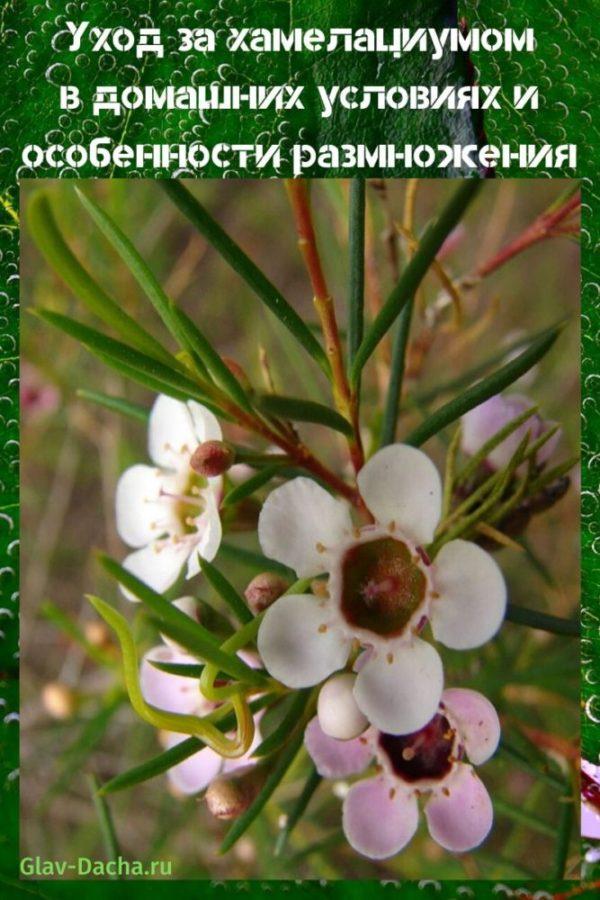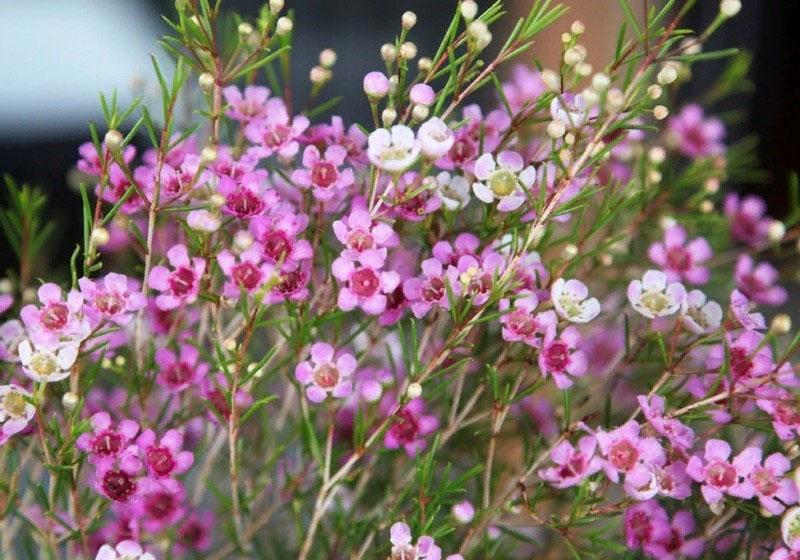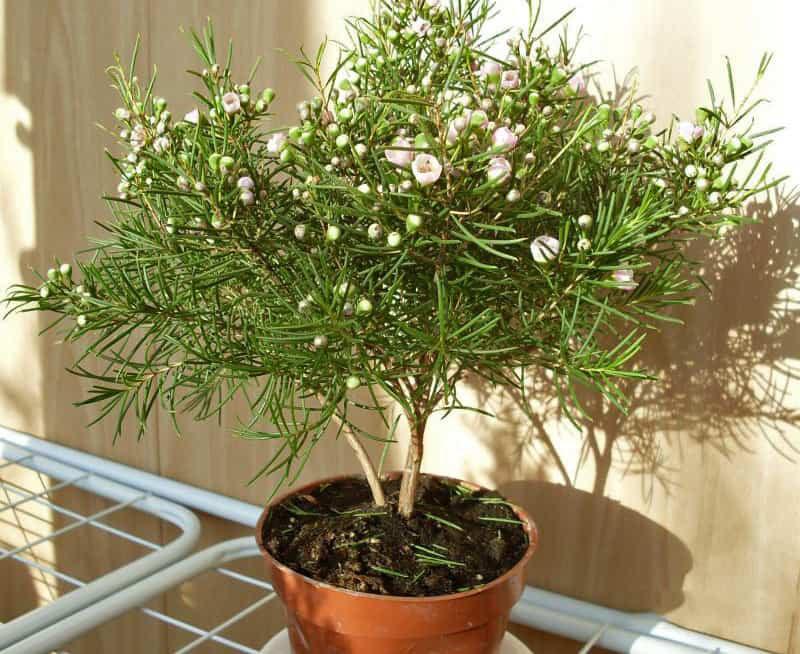Home care for chamelacium and breeding features
 According to the beliefs of most flower growers, caring for a chamelacium at home is not at all difficult. The most important factor in ensuring its normal development is proper watering.
According to the beliefs of most flower growers, caring for a chamelacium at home is not at all difficult. The most important factor in ensuring its normal development is proper watering.
Chamelaucium is a fairly hardy, and not so picky plant from the myrtle family. Although endemic to Western Australia, it has a Mediterranean climate with bright lighting and well-drained soil. Chamelacium hooked, known in everyday life as heraldon or wax myrtle, grows well in pots.
A close acquaintance with the chamelacium

Under the natural conditions of its native range, the height of this evergreen shrub can reach 4 m. Distributed in coastal areas, found on plains, low mountain slopes and wastelands.
Crooked chamelacium grown in homes grows very quickly. The length of its long leaves is about 4 cm. Young shoots are densely covered with them, but over time, the leaves begin to gradually fall off. Axillary flowers can be collected in small clusters. The plant blooms profusely, from the second half of February to mid-June.
 Breeders have bred many varieties of hooked chamelacium, the flowers of which can be double and semi-double, with the most unexpected shades of petals, where there are also two-color ones. The twigs of this luxurious plant are often used by florists in various compositions and bouquets.
Breeders have bred many varieties of hooked chamelacium, the flowers of which can be double and semi-double, with the most unexpected shades of petals, where there are also two-color ones. The twigs of this luxurious plant are often used by florists in various compositions and bouquets.
Home care for chamelacium
 Helatiums are plants that should be dealt with by experienced flower growers who have perfectly mastered the features of watering. It is for this reason that they are almost impossible to find in offices and salons.
Helatiums are plants that should be dealt with by experienced flower growers who have perfectly mastered the features of watering. It is for this reason that they are almost impossible to find in offices and salons.
Taking care of your chamelacium at home is not that difficult. When keeping a plant in an apartment, you need to adhere to those soil parameters that are characteristic of the southwest of Australia. Sandstones are low in nitrogen, calcium and phosphorus.
Conditions conducive to the normal development of chelation should be something like this:
- Illumination. It is advisable that the plant is located in the most illuminated place in the apartment, in direct sunlight, since, located in diffused light, it will not bloom. In the summer, it is better to take it out to balcony or place it on the veranda, in the garden, or at least create air circulation in the room. If this is not done, the roots and crown will overheat, which can lead to irreversible negative consequences. Plants get sick from a lack of light and even die, so they need to be supplemented with a phytolamp.

- The soil intended for the plant must conduct water well. Even before filling the container, add to the universal peat soil perlite, which should be at least 1/4 of the total volume and mix thoroughly. Sometimes it is advised to add moss and a little humus.In this case, moisture during irrigation does not stagnate, and air cavities form in the soil, due to which the roots of the chelacium do not rot.
- The moisture content of the soil is regulated by irrigation in such a way as to avoid complete drying out. But, at the same time, even a one-time waterlogging will not lead to anything good. In order for the soil to always be moderately moist, water after the top layer dries. Use soft, settled water, since an excess of calcium in the soil is undesirable. Lemon juice or a little aqueous solution of citric acid is added to it (no more than once every 10 days).

So that the crown of the chamelacium is not too voluminous and dense, in the summer, when the plant has already faded, all branches are shortened by 1/3, and some tops are pinched.
Growing secrets
 The soil for chamelacium should be neutral or acidic, low in nutrients. Sand is added to it.
The soil for chamelacium should be neutral or acidic, low in nutrients. Sand is added to it.
Nitrogen-containing fertilizers, as well as universal ones, are diluted much stronger than the indicated proportions, about two or three times, and added to the soil after the plants have faded. No additional feeding is required.
Phosphorus fertilizers are not suitable for chamelaciums. They react negatively to their introduction.
Watering is carried out regularly. But you need to remember that the earthen lump must periodically dry out. If the humidity in the room is greatly reduced, the leaves can be lightly sprayed with warm, settled water. However, this must be done carefully, since the plant is affected by late blight.
In order for the chamelacium bushes to remain compact, it is necessary not only to cut off the branches, but also to use retardants, drugs that restrain their growth.
When transplanting, the plants are transferred to another container along with an earthen lump, since the delicate roots are severely damaged. Therefore, flower growers often choose simple ceramic pots, which are broken at the time of transfer.
Reproduction of chamelacium by cuttings
 The seed propagation method is not effective for breeding chamelaciums. Growing a viable plant in this way is almost impossible. Except in rare cases, they all die, which sooner, which later. Many gardeners do not have much confidence that the reproduction of chamelacium by cuttings will give a good result.
The seed propagation method is not effective for breeding chamelaciums. Growing a viable plant in this way is almost impossible. Except in rare cases, they all die, which sooner, which later. Many gardeners do not have much confidence that the reproduction of chamelacium by cuttings will give a good result.
However, the odds are much higher here:
- Cuttings, 7-10 cm long, are harvested in January. Cut apical cuttings are treated with growth stimulants.
- Placed in a mixture of sand and peat.

- But you can try to root them in water.

- If the room temperature is stable, between 23-25 ° C, then after 8 weeks the cuttings will grow roots.

Experienced gardeners can learn another way to get seedlings - grafting. Good results can be achieved by inoculating Hamylaceum on Leptospermum and Kuncea.
Dangerous diseases and pests
 In addition to the intolerance of high soil moisture, which causes root rot in many plants, chamelaciums suffer from air humidity, coupled with a mismatch in temperature conditions. From this, gray rot appears on their leaves, which is not so easy to get rid of.
In addition to the intolerance of high soil moisture, which causes root rot in many plants, chamelaciums suffer from air humidity, coupled with a mismatch in temperature conditions. From this, gray rot appears on their leaves, which is not so easy to get rid of.
At home, chamelacium care should include mandatory insect control. Despite the high content of essential oils, the plant has enemies among pests - mealybug, spider mite and others. But especially a lot of harm is caused by aphids, against which it is necessary to use special preparations.
Types of chamelacium
There are 14 plant species in the chamelacium genus, which are evergreen shrubs. Some are grown at home:
- A hooked, heraldon or wax flower. This type includes a hybrid "Dancing queen" with spectacular double flowers in pink.

- Darwinia. This small shrub, no more than 50 cm high, is highly prized by florists and bonsai creators.

- Matilda. A plant with a very dense crown. Easily tolerates short-term cold snaps.Therefore, this type of chamelacium grows in open ground in the southern regions of the country.

Hamelaciums need long-term lighting. Even in winter conditions, their daylight hours should be at least 12 hours. And in the spring, plants will certainly delight their owners with abundant flowering and a wonderful aroma.